1145-55
1145-55
Built as one of the last parts of the Romanesque Church of Chartres, the west portals, or so-called Royal Portals, are one of the few surviving parts of the earlier church incorporated into the High Gothic Church constructed after the devastating fire of 1194. These portals are the major monument of Early Gothic sculpture. They are clearly based on the now fragmentary portals of St. Denis.
The different fields of sculptural decoration, including the tympanum, archivolts, lintel, and jamb figures, are clearly derived from comparable forms in Romaneque portal sculpture. Compare for example the Royal Portals to the portal from Moissac:
An important theme in Early Gothic sculpture like architecture is integration. For example, note the integration of the different elements of the portal evident in view of the south portal or Incarnation portal:
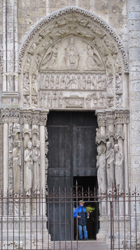
Notice in particular the diagonal splaying of the jambs and archivolts which allow them to be connected.
The theme of integration can also be seen in the overall programme of the sculptural decoration where all the elements are coordinated into a coherent iconographical plan focusing on the Comings of Christ in the Christian plan of history. The tympanum of the south or right portal focuses on the theme of Incarnation:
The Incarnation is the theme of the north portal of the narthex portals at Vezelay. Compare the treatment of this Romanesque portal done to the Early Gothic of Chartres.
The lintels of the Royal Portals represent episodes from the infancy story of Christ beginning on the lower left with the Annunciation followed by the Visitation, the Nativity, and the Annunciation to the Shepherds. The upper lintel focuses on the story of Christ's Presentation in the Temple. The tympanum is dedicated to an image popular in Romanesque art, the Sedes Sapientiae or Throne of Wisdom:
Christ as Wisdom is formally seated in the lap of His mother the Virgin who is understood as Ecclesia or the Church. This theme took on greater significance at Chartres since the church was dedicated to the Virgin. Also Chartres during the twelfth century was the site of a very important cathedral school. Significantly, the archivolts can be identified as the Seven Liberal Arts and their practitioners:

Here the second figure from the bottom can be identified as the personification of Music playing bells while the figure to the right is Grammar holding a switch disciplining her students. The figures beneath them have been identified as Pythagoras and either Priscian or Donatus, two noted Latin grammarians. Above the personification of Grammar in the outer archivolt appears probably the ancient astronomomer Ptolemy. Above him appears the personification of Astronomy who gazes to the heavens while holding an unidentified object in her left hand. The appearance of the liberal arts here makes the contrast between the divine knowledge or wisdom of Christ as opposed to the human knowledge of the liberal arts. In this program all knowledge is seen to be derived from and returns to Christ. The representation of the Liberal Arts can be compared to the illustration from the Hortus deliciarum of Herrad von Landsberg from the later 12th century.
In the miniature the female personification of Philosophy is in the center bearing scroll that all wisdom comes from God.
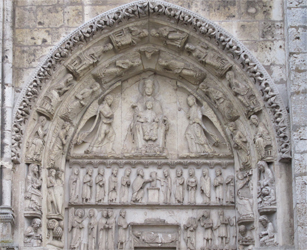
Note how the central axis of the tympanum and lintels integrates the different levels with Christ as the center. On the bottom lintel Christ is placed on a form that has been identified as an altar beneath which lies the Virgin. In the upper lintel Christ is placed over an altar, while the lap of the Virgin in the Sedes Sapientiae can be understood to be like an altar. The repeated references to the association of Christ to the altar make the point that we should not just see this as a narrative of the infancy of Christ but also as the eternal "incarnation" of Christ in the sacraments of the Church.
Balancing the Incarnation on the north or left portal is a representation that has generally been identified as the Ascension of Christ:
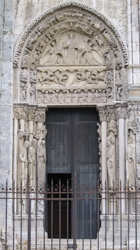
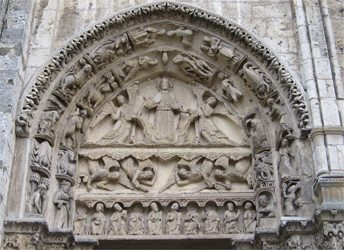
The figure in the center of the tympanum appears to be Christ assisted by two angels ascending above the clouds. In the lintel below appear four angels swooping down to the group of ten seated figures in the lower lintel. Generally it has been understood that there are ten figures because when the portal was repositioned into the new facade of the High Gothic church it was necessary to delete two figures thus making the ten figures the apostles. This would make the portal to be a combination of the Ascension of Christ with the Mission of the Apostles echoing the comparable conflation that occurred on the central portal of the narthex of Vezelay:
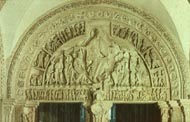
The significance of the number ten would not have been lost on the medieval observer: a symbol for the Ten Commandments. The archivolts of the Ascension portal represent symbols of the zodiac and the labors of the months:
Reading the outer archivolt clockwise, the figure at the bottom is the Labor for August with a man sheathing grain. Above is the zodiac symbol of Leo, while above this is the Labor for September of picking grapes. The inner archivolt begins at the bottom with the Labor for May, man holding a hawk stands by a horse. Next appears the zodiac symbol of Taurus, followed by the Labor for June, a man cutting hay with a now lost scythe. We have seen the combination of symbols of the zodiac and the labors of the month in Romanesque sculpture like Vezelay and St. Lazare at Autun:

We can thus look at the Incarnation Portal as the entrance of Christ into the world while the Ascension rerpresents Christ leaving temporal existence and returning to God. This leads to the culmination of the iconographical programme with the central portal representing the Christ in Majesty at the Second Coming:
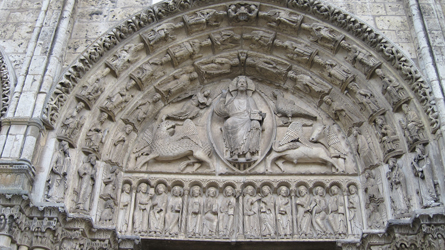
Christ is placed in the center within a mandorla of light and is flanked by the four beasts of the Apocalypse. On the lintel appears the Twelve Apostles significantly divided into four groups of three figures. The single figures at either end of the lintel have been identified as the Old Testament prophets Enoch and Elijah who are noted for their prophecies pertaining to the Second Coming. The figures in the archivolts are the 24 Elders. This makes an excellent comparison to the treatment of the same subject matter at Moissac:

Compare and contrast especially the central figures of Christ in Majesty from the two tympana:
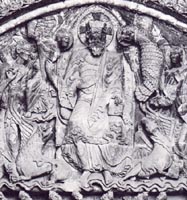
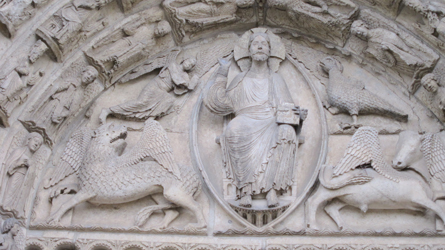
The tympana, lintels, and archivolts thus focus on the pivotal events in Christ's mission as part of the Divine Plan: Christ's entrance into the world through the Incarnation, His departure with the Ascension completing his earthly ministry, and His Second Coming at the end of time. The capitals below illustrate the life of Christ.
The jamb figures that flank the portals are understood to be based on the corresponding figures from the now largely destroyed portals of St Denis. Eighteenth century engravings by Montfaucon give us an idea about the original jamb figures at St Denis:
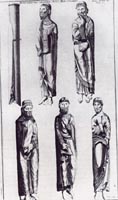
The jamb figures at St Denis are understood to be representations of the royal lineage of Christ in the Kings and Queens of the Old Testament. This theme of kingship was central to Abbot Suger's ideology. These Old Testament Kings and Queens were not only understood as ancestors of Christ but important precursors for the Kings and Queens of France. We have already noted this theme in the treasury of St Denis which link the French Kings back to kings like Solomon, the Ptolomies, Charlemagne, etc.
Although scholars still debate about specific identifications, the jamb figures of Chartres clearly extend this theme of kingship:
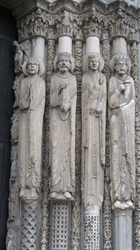
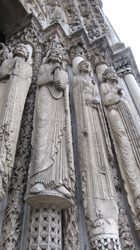
The logic of the portal design clearly connects these jamb figures to the figures above, clearly defining the Divine source of Royal power in the image of Christ in Majesty. These jamb figures also serve for us entering the church as intermediaries to the figures above. This thus places us in relationship to this hierarchy of power descending from Christ above to the symbols of earthly kingship below.
These jamb figures also present significant comparisons to Romanesque precedents. For example compare these figures to Romanesque figures like the St Paul from the trumeau of Moissac:
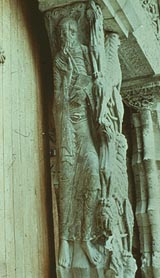
Or the Sts Peter and Paul figures from Vezelay:

Closer examination of the jamb figures from Chartres reflects a considerable change in style:
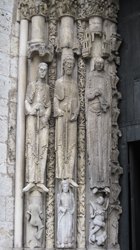

Romanesque elements are still apparent in details like the crossed leg motif:

But notice the considerable difference in form from figures like the Prophet Jeremiah from the trumeau of Moissac:
Web Sources:
Alison Stones, Images of Medieval Art and Architecture: Chartres.